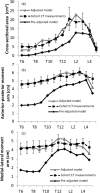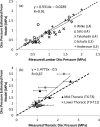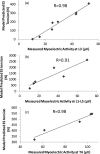Development and Validation of a Musculoskeletal Model of the Fully Articulated Thoracolumbar Spine and Rib Cage
- PMID: 25901907
- PMCID: PMC5101035
- DOI: 10.1115/1.4030408
Development and Validation of a Musculoskeletal Model of the Fully Articulated Thoracolumbar Spine and Rib Cage
Abstract
We developed and validated a fully articulated model of the thoracolumbar spine in opensim that includes the individual vertebrae, ribs, and sternum. To ensure trunk muscles in the model accurately represent muscles in vivo, we used a novel approach to adjust muscle cross-sectional area (CSA) and position using computed tomography (CT) scans of the trunk sampled from a community-based cohort. Model predictions of vertebral compressive loading and trunk muscle tension were highly correlated to previous in vivo measures of intradiscal pressure (IDP), vertebral loading from telemeterized implants and trunk muscle myoelectric activity recorded by electromyography (EMG).
Figures






Similar articles
-
Musculoskeletal full-body models including a detailed thoracolumbar spine for children and adolescents aged 6-18 years.J Biomech. 2020 Mar 26;102:109305. doi: 10.1016/j.jbiomech.2019.07.049. Epub 2019 Aug 7. J Biomech. 2020. PMID: 31471110 Free PMC article.
-
Thoracolumbar spine model with articulated ribcage for the prediction of dynamic spinal loading.J Biomech. 2016 Apr 11;49(6):959-966. doi: 10.1016/j.jbiomech.2015.10.010. Epub 2015 Nov 30. J Biomech. 2016. PMID: 26684431
-
Anatomy of the trunk. A review: part I.Phys Ther. 1974 Jul;54(7):722-44. doi: 10.1093/ptj/54.7.722. Phys Ther. 1974. PMID: 4422898 No abstract available.
-
A Cervico-Thoraco-Lumbar Multibody Dynamic Model for the Estimation of Joint Loads and Muscle Forces.J Biomech Eng. 2015 Nov;137(11):111001. doi: 10.1115/1.4031351. J Biomech Eng. 2015. PMID: 26292160
-
Thoracic and lumbar spine trauma.Radiol Clin North Am. 1997 May;35(3):533-57. Radiol Clin North Am. 1997. PMID: 9167662 Review.
Cited by
-
Calibration and validation of a novel hybrid model of the lumbosacral spine in ArtiSynth-The passive structures.PLoS One. 2021 Apr 26;16(4):e0250456. doi: 10.1371/journal.pone.0250456. eCollection 2021. PLoS One. 2021. PMID: 33901222 Free PMC article.
-
The effect of muscle ageing and sarcopenia on spinal segmental loads.Eur Spine J. 2018 Oct;27(10):2650-2659. doi: 10.1007/s00586-018-5729-3. Epub 2018 Aug 28. Eur Spine J. 2018. PMID: 30155731
-
Subject-Specific Spino-Pelvic Models Reliably Measure Spinal Kinematics During Seated Forward Bending in Adult Spinal Deformity.Front Bioeng Biotechnol. 2021 Sep 1;9:720060. doi: 10.3389/fbioe.2021.720060. eCollection 2021. Front Bioeng Biotechnol. 2021. PMID: 34540815 Free PMC article.
-
Automated Segmentation of Trunk Musculature with a Deep CNN Trained from Sparse Annotations in Radiation Therapy Patients with Metastatic Spine Disease.medRxiv [Preprint]. 2025 Jan 20:2025.01.13.25319967. doi: 10.1101/2025.01.13.25319967. medRxiv. 2025. PMID: 39974027 Free PMC article. Preprint.
-
Musculoskeletal full-body models including a detailed thoracolumbar spine for children and adolescents aged 6-18 years.J Biomech. 2020 Mar 26;102:109305. doi: 10.1016/j.jbiomech.2019.07.049. Epub 2019 Aug 7. J Biomech. 2020. PMID: 31471110 Free PMC article.
References
-
- Delp, S. L. , Anderson, F. C. , Arnold, A. S. , Loan, P. , Habib, A. , John, C. T. , Guendelman, E. , and Thelen, D. G. , 2007, “OpenSim: Open-Source Software to Create and Analyze Dynamic Simulations of Movement,” IEEE Trans. Biomed. Eng., 54(11), pp. 1940–1950.10.1109/TBME.2007.901024 - DOI - PubMed
Publication types
MeSH terms
Grants and funding
LinkOut - more resources
Full Text Sources
Other Literature Sources

